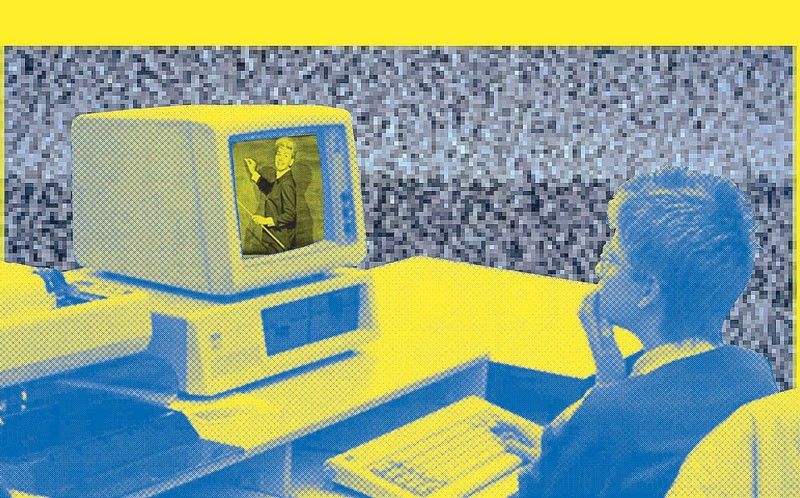Dispatch from Zoom university

Diskarte’ is a bad word,” my sociology professor told us from a tiny Zoom window. “It only persists when the system is not working.” Week after week we see a victim of systemic injustice and incompetent governance become the subject of the latest Filipino resiliency sob story — this time it was a grandmother-grandson pair joyed by a new smartphone. After their photo went viral, the grandmother revealed online classes are still off the table, due to their lack of internet access.
Earlier this month, Pamantasan ng Lungsod ng Maynila reopened applications and administered the entrance exam online. “A bigger view of the screen is an advantage. Any connectivity issues that may arise during the test proper shall be the examinee’s responsibility,” the test guidelines read. Foreseeably, many takers were unable to finish it. PLM is one of the state universities in the country that offers free tuition, a national effort to make college education supposedly within reach of more people. And while Manila Mayor Isko Moreno plans to distribute free tablets among his constituents to assist them in this virtual classroom setup, what good will it do if, as early as now, disadvantaged applicants are already being gatekept?
“We pushed for free tuition because we know not everyone has the ability to pay (tuition). They don’t have the financial capacity. And now students will have to pay for the internet to attend classes. Pinagbayad niyo rin ang estudyante,” says Irene Quilantang, a psychology professor from University of the Philippines Manila. Despite students and teachers making clear that access is not universal, online classes remain imminent. Universities like UP and University of Santo Tomas are already conducting their current semesters remotely. While students have the option not to enroll, such a refusal is not something everyone can afford. Being delayed means entering the workforce later, and for many that is not a viable option, especially during a recession. Capitalism has made time a resource too scant to be wasted. Having this kind of time to spare is only for the economically secure — otherwise it feels like every minute should be maximized and monetized.
Even then, enrollment does not guarantee learning, since the issue of access remains. “There’s the constant thought of, ‘Are all my classmates able to download the materials or study like me?’’ says Katrina, an Occupational Therapy student from UST. This lack of technological and financial capacity is a primary source of anxiety for students; they are uncertain if they can submit requirements and time-intensive exams before the deadline, or if they can even sustain their attendance. “It’s not a question of whether students are interested to learn — of course they are. The question is whether they have access to the platforms where they can attend online classes,” explains Quilantang.
Hindrances are not limited to technology: some homes are not conducive for remote or online learning. With entire families indoors it can be difficult for students to find quiet areas to study; a professor has jokingly called me out for attending her class from bed. Boundaries between work, rest and leisure dissolve, and this lack of work-life balance easily leads to burnout. Areas meant for rest are now being used to work (I am also writing this from bed). With our restricted mobility, we have nowhere to go to take breaks. Most importantly, not everyone feels safe at home. School as a “safe space” has been taken away by the pandemic; the anxiety of slow internet and faulty laptops now overlap with a fear for their safety.
The merging of work and rest areas come with the muddling together of our different responsibilities. Quilantang says the assumption that online classes are easier because it’s just “being at home” is itself problematic, because being at home does not absolve us from our other responsibilities. In fact, it’s harder to sustain activities because we are now more likely to multitask — a disrupted routine that leaves us trying to do everything at once within the home space. Push notifications are instantly seen and can instantly occupy our mental spac; answering emails and checking group chats during a Zoom session has become a frequent occurrence. Even Zoom itself is exhausting — BBC reports that video calls require more energy than face-to-face conversations. We have to focus more to interpret non-verbal cues, a process that comes more naturally in real life.
In fact, sustaining relationships is now more challenging despite the easy connectivity of social media. This is part of the reason why online classes are so tiring — school has many latent functions, including providing us with an additional support system, and this has been made inaccessible by remote learning. “This may not be directly related to classes, but it affects the person,” says Quilantang. “From the time you enter school, an important part of your development is your interaction with others. For adolescents, the most important people in their lives right now are their friends, and they can’t spend time together.” Ultimately, it’s more difficult to check up on friends and offer support when we’re apart.
This lack of physical contact — not only from remote learning, but also because of the need for physical distancing — affects our mental health, a concept psychology terms “skin hunger.” Quilantang explains: “We are biologically designed to long for physical touch. It’s important in terms of boosting our immune system and releasing hormones responsible for feelings of comfort and compassion and reducing stress. In this pandemic, the very thing we are biologically designed to need is (what) can harm us the most.”
On the other side of social media’s easy connectivity is the expectation that students are available to work 24/7. It is now easier to work anywhere, all the time, and online platforms serve as a common area where everyone is easily reachable. Jenny Odell, in her book How to Do Nothing, writes, “The workers no longer exist. Their time exists, their time is there, permanently able to connect.” Availability becomes an assumption because hindrances like distance are no longer present, and with everyone overstimulated by notifications, there is an increased sense of urgency that makes constantly being answerable hard to resist.
This begets an exacerbation of the already rampant glorification of overwork. With seemingly more time on our hands, we stress about wanting to spend it wisely. Rest is considered slacking off — work is easily within reach, why are you not doing it? Activities that produce things we cannot quantify, like enjoyment, are discarded. Everything we do must be a means to a capitalist end.
But working more does not always mean learning more, especially with the limitations of online learning. “Physical classes offer hands-on learning which is essential in my field,” says Willen, a medical technology student from De La Salle Medical and Health Sciences Institute. “In the future we will be in charge of laboratory tests that can help decide patients’ diagnoses; we can’t learn that through online classes.” Katrina, the OT student from UST, said that the learning materials they are given vary between professors — while some give out PowerPoint slides with audio recordings, others only gave them book-reading guides. “There is an increased academic pressure because they still expect us to perform as if we were (still) in school,” she says. Professor Quilantang has the same concern: “Some professors, unfortunately, equate posting slides and videos with teaching. Parang pinag-self-study mo lang yung students kung pagbabasahin mo lang naman pala sila ng slides.”
Because of these limitations of remote learning, Quilantang is wary about giving numerical grades at this time. “During this pandemic, grades are not a measure of a student’s ability, but rather a reflection of their socio-economic capacity,” she says. However, she adds that online classes should not be ruled out. Teachers can continue to teach, if they can. Let students who are capable of attending and doing coursework do the work. But we must not take it against students who can’t because they are financially and technologically challenged. After all, what we are doing right now is not online learning, but what experts call “emergency remote teaching.” We had virtually no time to prepare and adjust for this, and we feel frustrated that this is not what we signed up for. Unfortunately, as always, we are left with nothing but our diskarte.















